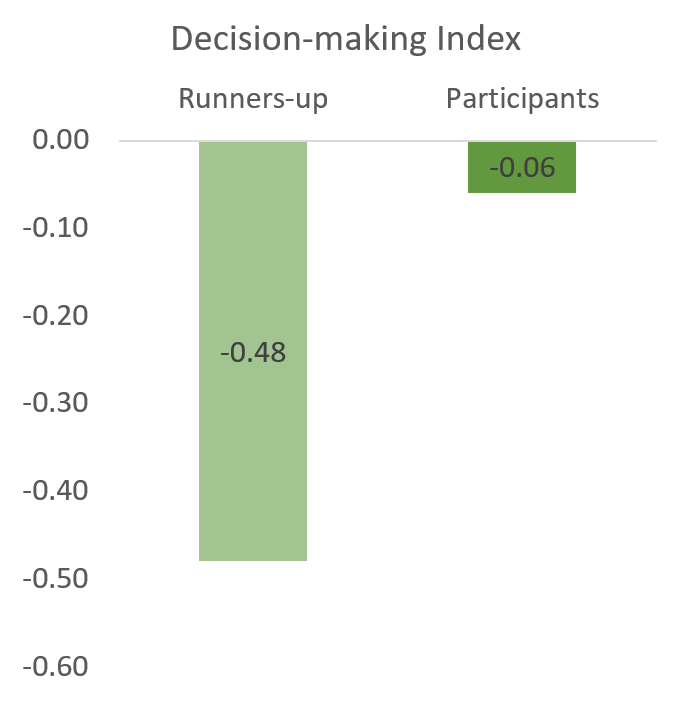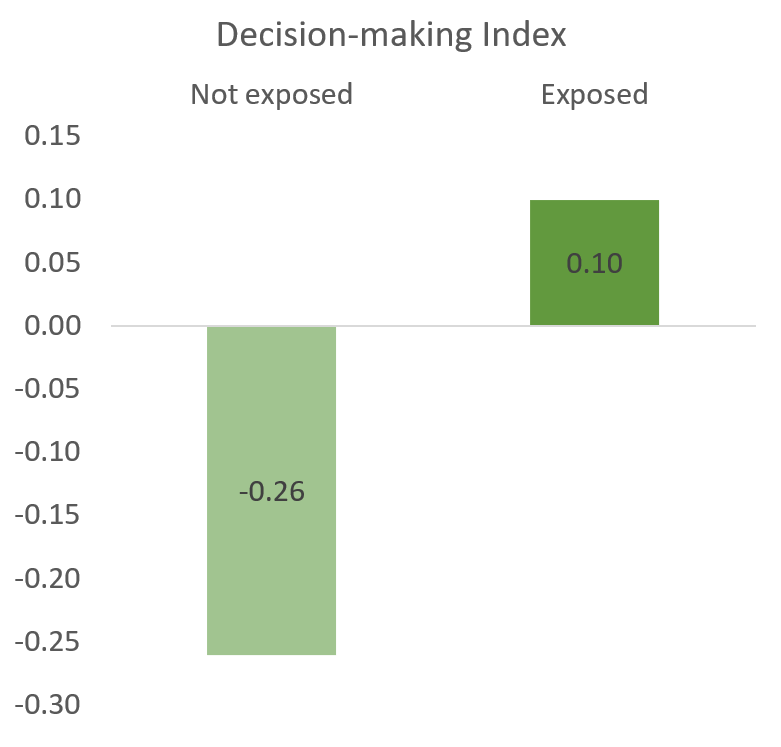
Promoting women at work increases female bargaining power in the household, both for new female managers and female staff exposed to them as role models
Policies to increase women’s participation in leadership positions are becoming more prominent (Nayar 2021). As of 2023, more than two thirds of all countries have at least one type of political quota for women, 43 countries had introduced a quota for company boards, and many companies voluntarily offer training programmes or mentorship opportunities that aim to increase women’s representation in management (International IDEA, CWDI 2023).
Despite their growing importance, little is known about the effect of such policies on the household. While most empirical evidence shows that entering employment improves a woman’s bargaining position in the household (Heath and Jayachandran 2018, Duflo 2012), it is unclear whether advancing in their careers will further affect female workers’ decision-making power in the home. And while there is some evidence of positive externalities of political quotas on girls’ outcomes (Beaman et al. 2012), evidence is lacking on potential externalities of female role models in the workplace. My paper (Uckat 2023) investigates these questions in the context of Bangladesh’s garment industry.
Women in Bangladesh’s garment industry are limited to the non-managerial level
Even though about 80% of production-line workers in Bangladesh’s garment industry are typically female, few hold managerial positions. The garment industry is the main source of formal wage employment for women in the country, in a society where women traditionally did not work outside the home (Asadullah and Wahhaj 2016). Nevertheless, the positions available to women in the industry continue to be limited to the non-managerial level, similar to many industries across the world. Women represent only about 5% of line supervisors, the lowest-level management position (Macchiavello et al. 2020, Menzel and Woodruff, 2021). Using extensive surveys conducted with the women and their spouses, I study the impacts on intra-household bargaining if a woman gets promoted from production-line operator to line supervisor, both for the promoted woman herself and for the female line operators working under her.
Comparing participants and runners-up of a promotion programme for women
The analysis exploits quasi-random participation in a career promotion programme for women in 27 large garment factories in Dhaka division. It was implemented in cooperation with the International Finance Corporation and the International Labour Organization, and is explained in more detail in Uckat and Woodruff (2020). As part of the promotion programme, the participating female production-line operators trialed as line supervisors for two months, were trained for this role and, if successful, were officially promoted by the factories. The participating women therefore gained experience in a management position whose leadership responsibilities were very different from the work they did before, even if not all of them were officially promoted.
In a quasi-experiment, I compare outcomes of women who participated in the promotion programme to runners-up who were eligible and short-listed but did not join the programme because of space constraints. The nomination process was as follows: at the beginning, factory management determined the number of women they wanted to promote as a factory-specific cut-off. The management then provided a ranked list of women they wanted to nominate for a promotion, from which the research team excluded those who did not pass extensive eligibility checks. These checks meant that only highly skilled and experienced operators with a supportive family were included in the shortlist for the programme. Out of the eligible and shortlisted operators, only those with a rank that was better than the factory-specific cutoff participated in the promotion programme. The comparison group consists of the runners-up who passed all diagnostic checks but continued to work as production-line operators.
To argue that this comparison is valid, I conduct extensive tests showing that the two groups do not differ on observable criteria. The main argument for validity is that, while it might be easy for factories to identify operators who would not make a good supervisor in their factories, it is much harder to decide the ranking among a largely homogenous sample of women who had all been judged to be suitable after an extensive screening. I use three estimation approaches for the analysis: a machine-learning technique to choose predictive control variables for OLS (PDS Lasso following Belloni et al. 2013, 2014a, 2014b, 2016), a regression discontinuity approach using the operator rankings, and a matching method. They all lead to the same conclusions.
Being promoted gives women more decision-making power in the household, and increases expenditures on women, girls, and remittances
The programme indeed helped get women promoted. Participants are three times more likely to be officially promoted than the nominated runners-up in the year after the programme, a change of 24 percentage points. Personal income for the participants is about 7% higher, but this difference is insignificant.
The participating women report being more involved in making decisions at home in the first six months after the programme, with a large impact of 0.42 SD on a decision-making index capturing seven different decision domains (see Figure 1). I observe the largest effects on women’s involvement in clothing purchases, accepting a promotion, and purchases and repairs of large household items.
Figure 1: Effects of the promotion programme on participating women’s decision-making power

Notes: Results are from a mean-comparison OLS regression with control variables chosen by post-double selection Lasso from a high-dimensional set of possible controls. Only survey wave 1 is included.
I find that the promoted women can translate this increased decision-making power into higher household expenditures on assignable goods for women (by 51%), for girls (74%), and on remittances to the family (58%), see Figure 2. Conversely, there is no similar increase in expenditures for men and boys. A back-of-the-envelope calculation shows that the increase in expenditures on female assignable goods and remittances (1,543 Taka) is more than two times larger than the estimated income increase from participation in the programme (689 Taka). This indicates that women gain agency over household income more generally and not just over possible additional income resulting from a promotion.
It is also important to note that variables that capture other spheres of bargaining do not appear to change, such as the likelihood of working, time use, or domestic violence.
Figure 2: Effects of the promotion programme on participating women’ household expenditures on assignable goods and remittances

Notes: Results are from a mean-comparison OLS regression with control variables chosen by post-double selection Lasso from a high-dimensional set of possible controls. Both survey waves are pooled, standard errors are clustered at the individual level.
Spillover effects: Female staff exposed to the new managers as role models report more say in household decisions
The impacts of the programme are not limited to the households of promoted women, but also affect other women in the workplace. To investigate spillover effects, I compare outcomes of female operators who worked under the new female managers to female line operators working on other lines. According to industry experts, the assignment of operators to production lines is determined by production requirements, and extensive tests show that these two groups are comparable on observable characteristics.
The staff exposed to the new female managers as role models also report significantly higher decision-making power at home. Again, the effects on the decision-making index are large at 0.36 SD (see Figure 3), especially for decisions about the women’s mobility. In contrast to the direct effects on participants in the promotion programme, however, I find very limited effects on expenditures.
Figure 3: Spillover effects on the decision-making power of female staff exposed to female managers

Notes: Results are from a mean-comparison OLS regression with control variables chosen by post-double selection Lasso from a high-dimensional set of possible controls. standard errors are clustered at the line level.
Policy implications
These results indicate that there are complementarities between the position a woman holds in the workplace and her role in the household which go beyond whether a woman works or not. While it will be important to replicate these results in other contexts, the findings suggest that policies to promote female advancement at work – such as quotas, training, mentorship opportunities, or more flexible work policies – may have the potential to address inequities in the household at the same time.
This holds true for the promoted women themselves but, importantly, also benefits other women. Given that promotions typically only affect a small share of the working population, the positive externalities of a female role model in the workplace on female staff’s intra-household bargaining power that I document make a strong case in favour of expanding policies to increase female leadership in the workplace.
References
Asadullah, M N, and Z Wahhaj (2016), “Missing from the Market: Purdah Norm and Women’s Paid Work Participation in Bangladesh”, IZA Discussion Paper No. 10463.
Beaman, L, E Duflo, R Pande, and P Topalova (2012), “Female Leadership Raises Aspirations and Educational Attainment for Girls: A Policy Experiment in India”, Science, 335(6068): 582–586.
Belloni, A, V Chernozhukov, and C Hansen (2013), “Inference for High-dimensional Sparse Econometric Models”, Advances in Economics and Econometrics: 10th World Congress, 3: 245-195.
Belloni, A, V Chernozhukov, and C Hansen (2014a), “High-dimensional Methods and Inference on Structural and Treatment Effects”, Journal of Economic Perspectives, 28(2): 29–50.
Belloni, A, V Chernozhukov, and C Hansen (2014b), “Inference on Treatment Effects after Selection among High-dimensional Controls”, Review of Economic Studies, 81: 608–650.
Belloni, A, V Chernozhukov, C Hansen, and D Kozbur (2016), “Inference in High-Dimensional Panel Models With an Application to Gun Control”, Journal of Business and Economic Statistics, 34(4): 590–605.
Corporate Women Directors International, CDWI (2023), “Countries with Quotas for Publicly Listed and State Owned Companies”, [Online] Available here.
Duflo, E (2012), “Women Empowerment and Economic Development”, Journal of Economic Literature, 50(4): 1051–1079.
Heath, R and S Jayachandran (2018), “The Causes and Consequences of Increased Female Education and Labor Force Participation in Developing Countries”, In Averett, S L, L M Argys, and S D Hoffman (eds), The Oxford Handbook of Women and the Economy, Oxford University Press, New York, NY.
International Institute for Democracy and Electoral Assistance, International IDEA (2023), “Gender Quotas Database”, [Online] Available here.
Macchiavello, R, A Menzel, A Rabbani, and C Woodruff (2020), “Challenges of Change: An Experiment Promoting Women to Managerial Roles in the Bangladeshi Garment Sector”, NBER Working Paper No. 27606.
Menzel, A and C Woodruff (2021), “Gender wage gaps and worker mobility: Evidence from the garment sector in Bangladesh”, Labour Economics, 71(May): 102000.
Nayar, J (2021), “Equal Representation? The Debate Over Gender Quotas (Part 1)”, Harvard International Review, [Online] Available here.
Uckat, H (2023), “Leaning in at Home: Women’s Promotions and Intra-household Bargaining in Bangladesh”, World Bank Policy Research Working Paper 101370, [Online] Available here.
Uckat, H and C Woodruff (2020), “Learning How to Choose or Learning How to Lead? Experiments on Selecting and Training Female Managers in Bangladesh’s Garment Industry”.

